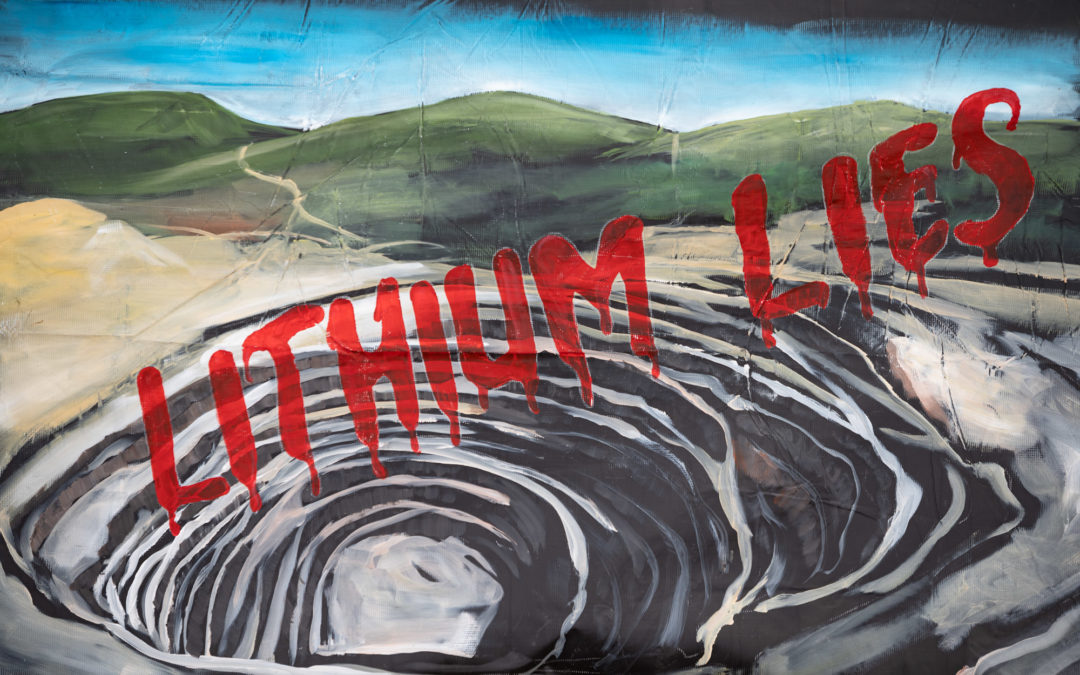In advance of Lithium Nevada representatives visiting Orovada today, Protect Thacker Pass wants to share some information about lies and misleading statements the company has made in the past (as recently as yesterday, at their community meeting in McDermitt). Our conclusion is that this company has a history of lying, and they cannot be trusted to tell the truth now or in the future.
Lies Lithium Nevada Has Told
1) “This Project Won’t Pollute Groundwater.”
It is expected that the mine will pollute groundwater. Lithium Nevada’s own tests found that aluminum, arsenic, antimony, beryllium, cadmium, chromium, copper, fluoride, iron, lead, magnesium, mercury, nickel, sulfate, thallium, TDS, and zinc were leached at concentrations above Nevada Resource Values. (Final Environmental Impact Statement (FEIS) Appendix B, LNC Mine Plan, pg. 41).
LNC also found that for their clay tailings sample uranium, gross alpha and radium 226/radium 228 exceed Nevada Resource Values. (FEIS Appendix B, LNC Mine Plan, pg. 41).
Federal law requires projects to comply with applicable state water quality standards. The Final Environmental Impact Statement prepared by Lithium Nevada and approved by BLM clearly states that levels of antimony, a harmful pollutant, will be released into the groundwater at levels that will exceed state water quality standards.” (FEIS, pg. R-121).
The Environmental Protection Agency – one of those federal agencies Lithium Nevada Chairman Evans claims his corporation aims to have a thorough process working with – has strongly criticized the way Lithium Nevada’s final Environmental Impact Statement failed to adequately analyze water pollution. The Environmental Protection Agency stated about the Thacker Pass mine’s potential to contaminate groundwater: “…the plans are not developed with an adequate level of detail to assess whether or how groundwater quality downgradient from the pit would be effectively mitigated.” (EPA’s Detailed Comments on the Final Environmental Impact Statement for the Thacker Pass Project, Humboldt County, Nevada, January 4, 2020, pg. 1)
The Environmental Protection Agency also said that Lithium Nevada’s statements “that groundwater quality management plans would ‘effectively mitigate impacts to groundwater quality downgradient from the pit’ are not adequately supported.”
EPA has stated: “As explained in the Final EIS, adverse effects to groundwater quality are expected from all action alternatives. Without mitigation, a plume of groundwater exceeding the Nevada Division of Environmental Protection Profile I Reference Values for antimony is expected to flow uncontrolled from the backfilled pit.”
2) “Lithium Nevada is Collaborating With Local Stakeholders”
In his declaration in federal court, Evans also stated that Lithium Nevada has been collaborating with local stakeholders.
In reality, Lithium Nevada has been dishonest with local stakeholders.
Local rancher Edward Bartell is responsible for one of the lawsuits challenging the mine. While trying to convince the Bureau of Land Management to take local concerns seriously, he explained how, in late 2019, he asked Lithium Nevada’s CEO Alexi Zawadzki for the water studies Lithium Nevada had done of the area. Zawadzki responded, in writing, that the Thacker Pass mine would only use approximately 2,500 acre-feet of well water per year. However, when the Draft Environmental Impact Statement was published, just a few months later, Lithium Nevada revealed that while the mine would actually use 2,600 acre-feet of water for the first 4 years of the mine’s operations, it would use 5,200 acre-feet of water for the next 37 years.
In this letter, Bartell accused Lithium Nevada of using “BLM’s scoping process to misinform the public.” According to Bartell, at community scoping meetings in February, 2020, Lithium Nevada made presentations that only included the same 2,500 acre-feet of water use in the first phase of the project and did not include the 5,200 acre-feet Lithium Nevada expects to use in the second phase of the project.
Bartell also stated that a presentation including the same misrepresentation was made by Lithium Nevada at the Humboldt County Commissioners meeting on July 26, 2020 and that two articles in the Sierra Nevada Ally and the Elko Daily Free Press quoted Lithium Nevada still using the 2,500 or 2,600 acre foot number.
To be clear, according to Bartell, Lithium Nevada told folks the mine would only use half the amount of water that Lithium Nevada actually expected to use.
Bartell also alleges that Lithium Nevada employees or contractors trespassed on his property, tampered with his wells, and underestimated the flow rates on several creeks and springs on or near the project site in what may be a deliberate attempt to manipulate scientific data to support their mining plan.
3) “There Will Only Be 72 Semi-Trucks Per Day”
At the April 5, 2021 community meeting in McDermitt, company spokesperson Tim Crowley stated that 72 trucks per day will run between Winnemucca and the mine at Thacker Pass. Crowley appears to be lying or misleading the public.
According to the FEIS, for the first four years, between 60 to 100 trucks will make one-way trips from Winnemucca, through Orovada, to the Thacker Pass project site. These trucks would run 24-hours a day (FEIS, pg. 2-14). That is 120-200 trucks passing per day, when you count round trip.
For the next 37 years, the truck traffic would increase to between 120-200 one-way trips from Winnemucca, through Orovada, to the Thacker Pass project site. That’s 240-400 semi trucks passing per day, roughly one every 4 minutes (FEIS, pg. 2-14).
If the mine expands into the exploration zone (see next point), these numbers may rise further.
4) “This Mine Has a Small Footprint”
Lithium Nevada has repeatedly claimed this mine will have a “small” footprint of 5,694.8 acres. However, at the April 5, 2021 community meeting in McDermitt, company spokesperson Tim Crowley stated that they are “very confident that there will be more development even beyond that 46 years” which the project has been permitted for. The company plans to expand their mining operation into their “exploration zones” on the south and east sides of Thacker Pass. This would expand the project size to 17,933 acres.
Lithium Nevada has also staked mining claims in the Montana Mountains, and market pressures make it likely that they, or another mining company, will expand lithium mining into the highlands of the Montana Mountains in coming years. Another mining company (Jindalee) is already conducting test drilling for lithium west of McDermitt. Market demands may threaten most of the McDermitt Caldera with lithium mining in coming years.
5) “We’ve Designed a Very Environmentally Responsible Mine.”
A Lithium Nevada publicity video states that “We’ve designed a very environmentally responsible mine.” In truth, the Thacker Pass mine threatens important habitat for mule deer, pronghorn antelope, sage-grouse, and other species, and threatens access to areas frequented by local hunters.
The mine would disturb at least one golden eagle breeding pair. (FEIS, 4-56). There are also 7 golden eagle nests within 1mile of the proposed project boundary, and 12 golden eagle nests within 2 miles of the project boundary. (FEIS, 4-57)
The mine would also disturb approximately 852 acres of year-round mule deer habitat. (FEIS, pg. 4-38). It would directly affect 427 acres of pronghorn summer range and 4,960 acres of winter range over the life of the mine. (FEIS, pg. 4-38). Many special-status species and their habitat including bighorn sheep, pygmy rabbit, western burrowing owl, greater sage grouse, spotted bats, red bats, little brown bats, Lahontan cutthroat trout, and desert horned lizard would be harmed by the project. (FEIS, pg. 4-40 to 4-48).
—
To join the opposition to the Thacker Pass mine, contact us or visit the camp.


By their own admission:
“THERE WILL ~ONLY~ BE 72 SEMI-TRUCKS PER DAY”
Could we say that a little bit LOUDER for those in the back to hear. So you know there will be more because they are trying to make it sound like it is no big deal. Some one needs to explain to me how that will stop climate change!
As always the FEIS is hard to read and understand and way too long for absorption. Is it correct that approx 300 jobs will be created and for what period of time and socio-economic impact to community would give added info to the picture.
It’s hard to say at this point if the 300 jobs are real; the company plans to hire a variety of contractors to do the work (and has already announced several of these partnerships). Presumably these contractors will be staying on site or nearby at “man camps” while they work since there aren’t that many people in the immediate vicinity.
Most people in the Concerned Citizens group have jobs, they’re not really interested in mining jobs with the company. Fort McDermitt native folks generally feel they won’t be offered jobs, or if they are the jobs are poor recompense for the destruction of generations to come.
I really appreciate the thoughtful point by point explanation of the lies. I also appreciate the absence of dramatic over criticism unless I missed it. The light speak for themselves!